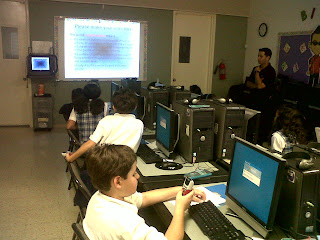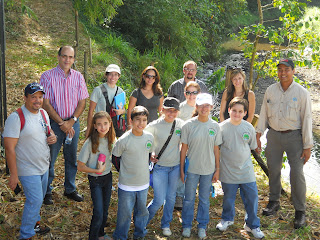Excitement! That was the environment that cover the computer lab and you could feel it just watching the facial expressions of students. We started our first meeting with the provision of a pre - test on the conceptualization to be used in the first part of the project: Data Collection with Vernier LabQuest. Students participated in this pre - test used Qwizdom ActionPoint technology . Once the pre-test was completed, students were given the folders with the initial project documents, identification, user name and password of Thinkquest.org. Then students would had to perform the first task: to break into groups and assign roles per student . After completing this task students began to learn on the use and management of LabQuest Vernier interface using an instructional module created in Adobe Captivate. The remaining time is devoted to students exploring the interface of the device using the Vernier LabQuest emulator.
Keep you informed on all the movements of these PR Water Cops CL.
Keep you informed on all the movements of these PR Water Cops CL.
Other members of the Environmental Sciences Club.
The students met in groups to divide the roles for each team.
Students taking the pre-test using Qwizdom ActionPoint.
Verifying the initial documents.
Kristian super excited!
On Saturday, the Environmental Science Club of Mater Salvatoris college undertook the difficult task of being the pioneers and founders of the PR Water Cops CL project. These five and six graders students said present to this new adventure.

Six children of the Enviromental Science Club came to environmental science activities with their parents. We also had the presence of Mr. Ray Rodriguez counselor of the Fideicomiso de Conservación de Puerto Rico , Dr. Basilio Santiago and also the coordinator of the Enviromental Science club, Mrs. Evalexa Tomei.
The day's agenda was quite charged. We started at 8:00 am at the second parking lot of the botanical garden, our meeting point . In this place Mrs. Evalexa took a record of attendees, an informal presentation of the participants and began with an orientation walk to the old aqueduct.
The guidance offered by Mr. Ray Rodriguez was of great environmental concern. Not only speak to children in the history of Rio Piedras and the old aqueduct but also about the flora and fauna that abounds here in this paradise that is called the lung of San Juan.
At 10:00 AM all students were snacking and hydrated, preparing theirself for the second part of the adventure: the water quality sampling. Students were divided into groups, took a orientation about the use and management of Vernier LabQuest and the sensors by Mr. José Hernández company Computer Learning Centers. Students also took a orientation about the use and management of video camera by the partner Rafael Carrión.
The student make measurements of water quality like temperature, pH, conductivity, dissolve oxygen, turbidity, latitude and longitude and finally stream flow. Was very interesting and they take notes in their data sheet.
The story continues...
On our second trip to Rio Piedras went to perform the water quality samples in the stream Guaralcanal, which is part of Rio Piedras. As part of our research will perform the same water quality samples we did last Saturday at the botanical garden, Rio Piedras.
We were honored to have Dr. Basilio Santiago again, which offered him a talk to students about the history of the gorge Guaralcanal, then move to the sampling of water quality in this area.
Students use Vernier technology LabQuest samples were collected at two points in the quebarada Guaralcanal. Using water sampling protocol these were three runs for each parameter that made our Vernier sensors. Students also documented the research taking video and photos, to use them in their articles, documentaries and blogs.


Eight Session - Data Analisys and Results - Vernier Logger Pro - ArcGIS Explorer Dynamic ModelWater quality collected points in the Rio Piedras can be considered generally acceptable for use on the water, national and domestic. Water quality in items collected from the Rio Piedras has decreased slightly over the years by urban expansion in this area. Activities such as: population growth, industrial and agricultural, in the near future, could create a negative impact on the water resource.Moreover according to data obtained during this investigation we conclude that the quality of water from this point of Rio Piedras is good. The levels of pH, conductivity, dissolved oxygen and turbidity are normal and optimal for the survival of aquatic organisms and for domestic use people.
This project is still at the stage of research and analysis of results. For this will create a dynamic model using ArcGIS technology, published a scientific paper to report results and in addition will prepare a "blog" for the publication of the results on the Internet.
This project is still at the stage of research and analysis of results. For this will create a dynamic model using ArcGIS technology, published a scientific paper to report results and in addition will prepare a "blog" for the publication of the results on the Internet.
PR Water Cops CL Documental Video











































